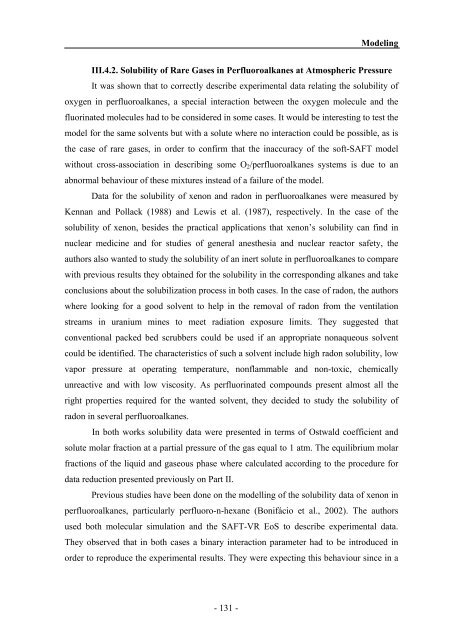n - PATh :.: Process and Product Applied Thermodynamics research ...
n - PATh :.: Process and Product Applied Thermodynamics research ...
n - PATh :.: Process and Product Applied Thermodynamics research ...
Create successful ePaper yourself
Turn your PDF publications into a flip-book with our unique Google optimized e-Paper software.
Modeling<br />
III.4.2. Solubility of Rare Gases in Perfluoroalkanes at Atmospheric Pressure<br />
It was shown that to correctly describe experimental data relating the solubility of<br />
oxygen in perfluoroalkanes, a special interaction between the oxygen molecule <strong>and</strong> the<br />
fluorinated molecules had to be considered in some cases. It would be interesting to test the<br />
model for the same solvents but with a solute where no interaction could be possible, as is<br />
the case of rare gases, in order to confirm that the inaccuracy of the soft-SAFT model<br />
without cross-association in describing some O2/perfluoroalkanes systems is due to an<br />
abnormal behaviour of these mixtures instead of a failure of the model.<br />
Data for the solubility of xenon <strong>and</strong> radon in perfluoroalkanes were measured by<br />
Kennan <strong>and</strong> Pollack (1988) <strong>and</strong> Lewis et al. (1987), respectively. In the case of the<br />
solubility of xenon, besides the practical applications that xenon’s solubility can find in<br />
nuclear medicine <strong>and</strong> for studies of general anesthesia <strong>and</strong> nuclear reactor safety, the<br />
authors also wanted to study the solubility of an inert solute in perfluoroalkanes to compare<br />
with previous results they obtained for the solubility in the corresponding alkanes <strong>and</strong> take<br />
conclusions about the solubilization process in both cases. In the case of radon, the authors<br />
where looking for a good solvent to help in the removal of radon from the ventilation<br />
streams in uranium mines to meet radiation exposure limits. They suggested that<br />
conventional packed bed scrubbers could be used if an appropriate nonaqueous solvent<br />
could be identified. The characteristics of such a solvent include high radon solubility, low<br />
vapor pressure at operating temperature, nonflammable <strong>and</strong> non-toxic, chemically<br />
unreactive <strong>and</strong> with low viscosity. As perfluorinated compounds present almost all the<br />
right properties required for the wanted solvent, they decided to study the solubility of<br />
radon in several perfluoroalkanes.<br />
In both works solubility data were presented in terms of Ostwald coefficient <strong>and</strong><br />
solute molar fraction at a partial pressure of the gas equal to 1 atm. The equilibrium molar<br />
fractions of the liquid <strong>and</strong> gaseous phase where calculated according to the procedure for<br />
data reduction presented previously on Part II.<br />
Previous studies have been done on the modelling of the solubility data of xenon in<br />
perfluoroalkanes, particularly perfluoro-n-hexane (Bonifácio et al., 2002). The authors<br />
used both molecular simulation <strong>and</strong> the SAFT-VR EoS to describe experimental data.<br />
They observed that in both cases a binary interaction parameter had to be introduced in<br />
order to reproduce the experimental results. They were expecting this behaviour since in a<br />
- 131 -



